Papers by Lorenzo Fantini

JCO precision oncology, Dec 1, 2019
PURPOSE Biomarkers for treatment personalization in metastatic castration-resistant prostate canc... more PURPOSE Biomarkers for treatment personalization in metastatic castration-resistant prostate cancer (mCRPC) could help improve patient outcomes. Multiple tests on blood have reported associations with poorer outcome, including serum lactate dehydrogenase (LDH), chromogranin A (CGA), neutrophil:lymphocyte ratio (NLR), and, recently, copy number (CN) of androgen receptor (AR) in plasma DNA. Biologic data suggest an association between choline uptake and AR signaling. We aimed to integrate 18 F-fluorocholine (FCH) uptake on positron emission tomography/computed tomography (PET/CT) scanning with plasma AR CN and other routinely obtained circulating biomarkers to evaluate their association with outcome. MATERIALS AND METHODS We determined plasma AR CN by digital droplet polymerase chain reaction from 105 mCRPC samples collected before abiraterone (n = 65) or enzalutamide (n = 40) therapy in the before (n = 26) and after (n = 79) chemotherapy settings. Pretreatment serum LDH, CGA, and NLR were also measured. FCH-PET/CT scan was performed at baseline, and maximum standardized uptake value (SUV max), total lesion activity (TLA), and metabolic tumor volume (MTV) were calculated. Main end points were the correlation of FCH-PET/CT parameters with circulating biomarkers and their impact on outcome. RESULTS Plasma AR CN gain was observed in 27 patients (25.7%), and it correlated significantly with higher median SUV max , TLA, and MTV values (P , .001). Kaplan-Meier curves showed significantly worse progressionfree survival and overall survival in patients with plasma AR gain and higher SUV max , TLA, and MTV values (P , .001 in each prognostic group). Conversely, no association was reported for prostate-specific antigen response. On multivariable analysis of overall survival, we showed as independent factors AR gain (hazard ratio [HR], 1.92;

Therapeutic Advances in Medical Oncology, 2021
Background: The aim of this study was to improve activity over single human epidermal growth fact... more Background: The aim of this study was to improve activity over single human epidermal growth factor receptor 2 (HER2)-blockade sequential neaodjuvant regimens for HER2-positive breast cancer, by exploiting the concomitant administration of trastuzumab, taxane and anthracycline, while restraining cardiac toxicity with use of liposomal doxorubicin, and by adding metformin, based on preliminary evidence of antitumor activity. Patients and methods: This multi-center, single-arm, two-stage phase II trial, assessed the safety and the activity of a new treatment regimen for HER2-positive, early or locally advanced breast cancer. Patients received six 21-day cycles of non-pegylated liposomal doxorubicin, 50 mg/m2 intravenously (i.v.) on day 1, docetaxel, 30 mg/m2 i.v. on days 2 and 9, trastuzumab, 2 mg/kg/week i.v. on days 2, 9, and 16 (with 4 mg/kg loading dose), in association with metformin 1000 mg orally twice daily. The primary endpoint was the rate of pathological complete response (p...
The Journal of Nuclear Medicine, 2010

European Journal of Nuclear Medicine and Molecular Imaging, 2020
Purpose To evaluate the clinical value of 68 Ga-PSMA PET/CT negativity in patients with biochemic... more Purpose To evaluate the clinical value of 68 Ga-PSMA PET/CT negativity in patients with biochemical recurrent prostate cancer (BCR). Methods One hundred three BCR patients (median age, 70 years; median PSA, 0.47 ng/mL) with negative 68 Ga-PSMA PET/ CT, followed up for at least 1 year, were retrospectively identified in a database of 1003 consecutive patients undergoing 68 Ga-PSMA PET/CT for BCR. Clinical recurrence (CR) was determined or excluded on follow-up imaging selected as per clinical practice. Clinical recurrence-free survival (CRFS) was computed from the date of negative 68 Ga-PSMA PET/CT to the date of evident disease; frequencies of CRFS were described as per ISUP patient subset (subset 1: ISUP grades 1 and 2; subset 2: ISUP grade 3; subset 3: ISUP grades 4 and 5) and other conventional variables. Results In 57 patients out of 103 (55.3%), CR was detected in the prostatic fossa (45.6%), nodes (38.6%), and bone (15.8%). The median CRFS was 15.4 months (range, 12.1-20.5), with a CRFS at 12 months in 61.4% of cases (range, 50.9-70.4) whereas the 24-month CRFS was 34.8% (range, 24-45.8). ISUP subset 1 benefited from significantly longer CRFS compared to subset 2 and subset 3 (median CRFS, 20.5 months, 12.6 months, and 12.1 months, respectively). ISUP subset 3 had significantly poorer 24month CRFS (9.3%) compared to subset 1 (47.8%) and subset 2 (33.5%). At the univariate and multivariate analyses, the ISUP subset was the only significant risk factor for clinical relapse; ISUP subset 3 and subset 2 patients held a higher risk of CR compared to subset 1 patients (HR of 2.75 [1.35-5.57] for subset 3 versus subset 1; HR of 2.08 [1.11-3.88] for subset 2 versus subset 1). Conclusion 68 Ga-PSMA PET/CT negativity in early BCR patients (PSA < 0.5 ng/mL) with low-grade primary prostate cancer (ISUP1 and 2) may support the exploration of a clinical surveillance approach in future prospective studies.
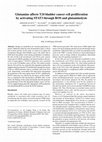
European Journal of Nuclear Medicine and Molecular Imaging, 2017
changes in metabolism are common phenomena in tumors. Glutamine (Gln) has been documented to play... more changes in metabolism are common phenomena in tumors. Glutamine (Gln) has been documented to play a critical role in tumor growth. In this study, we aimed to to explore the mechanisms through which bladder cancer cells utilize Gln to fulfill their biosynthetic needs during proliferation. In addition, the roles of Gln in the tricarboxylic acid (TcA) cycle, reactive oxygen species (ROS) regulation, and signal transducer and activator of transcription 3 (STAT3) expression were examined in vitro in the T24 bladder cancer cell line. The results revealed that the T24 cell line was markedly Gln-dependent and that Gln supplementation promoted T24 proliferation through the actions of Gln as a ROS moderator and as a metabolic fuel in the TcA cycle. Importantly, extracellular Gln deprivation deregulated the production of the transcription factor, STAT3. Additionally, STAT3 expression was affected by the degree of Gln metabolism, as regulated by Gln intermediates and ROS. Thus, on the whole, the findings of this study demonstrate that Gln promotes the proliferation of the Gln-dependent bladder cancer cell line, T24, by supplementing adenosine triphosphate (ATP) production and neutralizing ROS to activate the STAT3 pathway.
Proteases in Biology and Disease
... Chappell MC, Diz DI, Gallagher PE, 2001, The renin-angiotensin system and the exocrine pancre... more ... Chappell MC, Diz DI, Gallagher PE, 2001, The renin-angiotensin system and the exocrine pancreas. ... Fishman MP, Melton DA., 2002, Pancreatic lineage analysis using a retroviral vector in embryonic mice demonstrates a common progenitor for endocrine and exocrine cells. ...
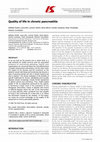
World Journal of Gastroenterology, 2006
In an era such as the present one in which there is a high demand for health services with the as... more In an era such as the present one in which there is a high demand for health services with the associated p r e s s u r e o f c o n t r o l l i n g s p e n d i n g , h e a l t h c a r e organizations are concerned about the cost-effectiveness of quality improvement interventions. On the other hand, the impact of the disease and the treatment on the patient's overall well-being and functioning has become a topic of growing interest not only in clinical research but also in practice. The clinical evaluation of the benefits of specific treatments for chronic, debilitating and incurable diseases should increasingly include formal assessment of patient activity and well-being. Thus, health-related quality of life as subjectively perceived by the patient, is becoming a major issue in the evaluation of any therapeutic intervention, mainly in patients with chronic or difficult diseases where the aim of the intervention is to keep patients either symptom-free and capable of living in the community for a long time or to reduce the discomfort caused by the disease. In this paper, we review the current knowledge on the quality of life assessment in chronic pancreatitis patients.
JOP : Journal of the pancreas, Jan 10, 2007
Advances in medical sciences, 2007

Pancreas, 2008
Objectives: To evaluate the adhesion molecule time course in the early phases of acute pancreatit... more Objectives: To evaluate the adhesion molecule time course in the early phases of acute pancreatitis and to explore the usefulness of these proteins in assessing the severity of the disease. Fifteen consecutive acute pancreatitis patients (10 patients with the mild and 5 with the severe disease) admitted to the hospital within 6 hours after the onset of pain and 15 age-and sex-matched healthy subjects. Methods: Vascular cell adhesion molecule 1, intercellular adhesion molecule 1, E-selectin, P-selectin, and L-selectin were quantified on hospital admission and for the following 2 days. Results: Acute pancreatitis patients had vascular cell adhesion molecule 1 and P-selectin concentrations significantly lower and Lselectin concentrations significantly higher than the healthy subjects. Only E-selectin was significantly higher in severe than in mild disease (P = 0.029); a value of E-selectin ranging from 3.83 to 3.92 ng/mL was the best cutoff value for differentiating severe from mild acute pancreatitis (sensitivity: 60.0%, specificity: 90.0%, cases correctly classified: 80%). E-selectin and P-selectin entered the multivariate logistic regression analysis, and a score was calculated showing a sensitivity of 93.3% and a specificity of 86.7% in identifying the patients with severe pancreatitis. Conclusions: This score seems to be useful for the early assessment of the severity of acute pancreatitis.
Pancreatology, 2007
atic insufficiency. Conclusions: Exhaled breath analysis can rapidly and easily assess the presen... more atic insufficiency. Conclusions: Exhaled breath analysis can rapidly and easily assess the presence of volatile compounds (H 2 S, NO and a substance having a molecular mass of 66 u) which may have properties capable of explaining, at least in part, the pathogenesis of CP.
Digestive and Liver Disease, 2005
Introduction.Health-related quality of life is becoming a major issue in the evaluation of any th... more Introduction.Health-related quality of life is becoming a major issue in the evaluation of any therapeutic intervention in patients with chronic or hard to cure diseases.

Clinical Nuclear Medicine, 2013
Purpose: This study aims to evaluate the role of 11 C-choline PET/CT in patients with biochemical... more Purpose: This study aims to evaluate the role of 11 C-choline PET/CT in patients with biochemical relapse after radical prostatectomy (RP) showing prostate-specific antigen (PSA) values lower than 0.5 ng/mL. Methods: We performed 11 C-choline PET/CT in 71 consecutive patients previously treated with RP showing PSA values lower than 0.5 ng/mL. 11 C-Choline PET/CT was performed following standard procedure. 11 C-Choline PET/ CTYpositive findings were validated by transrectal ultrasonography + biopsy, repeated 11 C-choline PET/CT, other conventional imaging modality, and histology. Results: 11 C-Choline PET/CT was true positive in 15/71 (21.1%). 11 C-Choline uptake was observed in pelvic lymph nodes (7/71; 9.9%), in the prostatic bed (7/71; 9.9%), and in bone (1/71; 1.4%). Mean PSA, PSA doubling time (PSAdt), and PSA velocity (PSAvel) values T SD in 11 C-choline PET/CTYpositive patients was 0.37 T 0.1 ng/mL, 3.4 T 2.1 months, and 0.05 T 0.1 ng/mL/yr, respectively. 11 C-Choline PET/CT was false negative in 2 patients and false positive in 1 patient. Among all variables, only PSAdt and the ongoing hormonal treatment were statistically significant in the prediction of a positive 11 C-choline PET/CT at multivariate analysis. Conclusions: 11 C-Choline PET/CT could be used early after biochemical failure even if PSA values are very low, preferentially in hormonal resistant patients showing fast PSA kinetics. An early detection of the site of relapse could lead to a personalized and tailored treatment.

Annals of Nuclear Medicine, 2010
Aim To assess the utility of 11 C-choline PET/CT in the restaging of prostate cancer (PC) patient... more Aim To assess the utility of 11 C-choline PET/CT in the restaging of prostate cancer (PC) patients who showed a single finding on bone scintigraphy (BS) that was classified as equivocal or suspected for metastatic lesion. Materials and methods A total of 25 PC patients with biochemical failure (mean PSA value 11.1 ng/mL; median value 6.3 ng/mL; range 0.2-37.7 ng/mL) after primary treatment were included in this retrospective study. All of them showed a single lesion on BS reported as suspected for metastatic lesion or as equivocal finding. Patients underwent 11 C-choline PET/CT within 1-4 months from BS. Validation was established by follow-up for at least 6 months. Results On the basis of biopsy confirmation and/or 6-month follow-up, 22 of 25 patients were classified as positive for the presence of metastatic bone lesions: 13 with a single lesion and 9 with multiple lesions. 11 C-choline PET/CT was positive in 19/25 patients and, on a lesion basis, it showed 50 positive findings. BS results were confirmed in 8/25 (32%) patients. 11 C-choline PET/ CT detected multiple sites of relapse in 11/25 (44%) patients: in 2/11, a single bone lesion associated with other extraosseous sites of relapse; in 6/11, multiple bone lesions; in 3/11, multiple bone lesions and other extraosseous localizations. Finally, 6/25 patients were negative on 11 C-choline PET/CT. In 3/6 patients, an osteoblastic lesion was seen on CT attenuation correction images (PET false negative; BS true positive), while in 3/6 patients only findings suggestive of the presence of degenerative disease were found (PET true negative; BS false positive). On a patient basis, 11 C-choline PET/CT showed a diagnostic sensitivity of 86% (19/22) and a specificity of 100% (19/19). Conclusions In our study, 11 C-choline PET/CT detected unknown lesions in 11/25 patients. Patients with a single equivocal finding on BS could have important additional information from 11 C-choline PET/CT study, especially in the detection of additional metastases, to choose an appropriate treatment. Keywords Prostate cancer Á Positron emission tomography (PET) Á Choline Á PSA Á Bone scan Introduction and aim Prostate cancer (PC) is the most common malignancy in men in Europe and the USA. This tumor shows variable biological behavior: from a clinically silent, indolent intra-prostatic tumor to an aggressive malignancy [1]. After
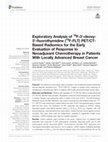
Frontiers in Oncology
PurposeThe objective of this study was to evaluate a set of radiomics-based advanced textural fea... more PurposeThe objective of this study was to evaluate a set of radiomics-based advanced textural features extracted from 18F-FLT-PET/CT images to predict tumor response to neoadjuvant chemotherapy (NCT) in patients with locally advanced breast cancer (BC).Materials and MethodsPatients with operable (T2-T3, N0-N2, M0) or locally advanced (T4, N0-N2, M0) BC were enrolled. All patients underwent chemotherapy (six cycles every 3 weeks). Surgery was performed within 4 weeks of the end of NCT. The MD Anderson Residual Cancer Burden calculator was used to evaluate the pathological response. 18F-FLT-PET/CT was performed 2 weeks before the start of NCT and approximately 3 weeks after the first cycle. The evaluation of PET response was based on EORTC criteria. Standard uptake value (SUV) statistics (SUVmax, SUVpeak, SUVmean), together with 148 textural features, were extracted from each lesion. Indices that are robust against contour variability (ICC test) were used as independent variables to l...
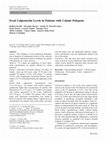
Digestive Diseases and Sciences, 2007
Context The usefulness of stool calprotectin determination in diagnosis of inflammatory disease o... more Context The usefulness of stool calprotectin determination in diagnosis of inflammatory disease of the colon has been reported; information about its usefulness for patients with polyposis are scarce, however. Objective To evaluate the significance of stool calprotectin concentrations for patients affected by colonic polyposis. Patients Sixty-three consecutive patients (35 males, 28 females, mean age 60.3 years, range 39-78 years) were enrolled: 26 patients (41.3%) with polyps, 17 patients (27.0%) with asymptomatic diverticular disease, and 20 subjects (31.7%) with normal endoscopic appearance of the colon. Results Stool calprotectin concentrations were 17.4 ± 24.5 lg g-1 for patients with colonic polyposis, significantly higher than concentrations for patients with diverticulosis (7.1 ± 5.7 lg g-1 ; P = 0.026) or for patients with normal appearance of the colon (calprotectin 6.0 ± 5.8 lg g-1 ; P = 0.003). For patients with a single polyp, stool calprotectin concentrations were similar to those for patients with multiple polyps. Calprotectin fecal concentrations for patients with sessile polyps and those with flat polyps were not significantly different. Calprotectin concentrations were not significantly related to the size of the polyps. Conclusion Our data show that colonic polyposis may cause an increase in stool calprotectin values and that these colonic lesions should be suspected when elevated stool calprotectin concentrations are found.
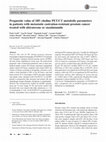
European journal of nuclear medicine and molecular imaging, Mar 6, 2017
The role of 18F-choline positron emission tomography/computed tomography (FCH-PET/CT) in patients... more The role of 18F-choline positron emission tomography/computed tomography (FCH-PET/CT) in patients with metastatic castration-resistant prostate cancer (mCRPC) has been firmly established in recent years. We analyzed the prognostic value of functional parameters such as mean standardized uptake volume (SUVmean), maximum standardized uptake volume (SUVmax), metabolic total volume (MTV; the volume of interest consisting of all spatially connected voxels within a fixed threshold of 40% of the SUVmax), and total lesion activity (TLA: the product of MTV and mean standardized uptake value) estimated with FCH-PET/CT in mCRPC patients in progression after docetaxel and treated with new antiandrogen receptor therapies, abiraterone or enzalutamide. We retrospectively studied 94 mCRPC patients, mean age 74 years (range 42-90), previously treated with docetaxel who were treated with either abiraterone (n = 52) or enzalutamide (n = 42). An FCH-PET/CT was performed at baseline, and patients were e...
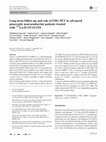
European Journal of Nuclear Medicine and Molecular Imaging, 2016
Purpose Lu-DOTATATE (Lu-PRRT) is a valid therapeutic option in differentiated pancreatic neuroend... more Purpose Lu-DOTATATE (Lu-PRRT) is a valid therapeutic option in differentiated pancreatic neuroendocrine tumors (P-NETs). FDG PET seems to be an important prognostic factor in P-NETs. We evaluated the efficacy of Lu-PRRT and the role of FDG PET in 60 patients with advanced P-NETs. Methods From March 2008 to June 2011, 60 consecutive patients with P-NETs were enrolled in the study. Follow-up lasted until March 2016. Eligible patients were treated with two different total cumulative activities (18.5 or 27.8 GBq in 5 cycles every 6-8 weeks), according to kidney and bone marrow parameters. Results Twenty-eight patients received a mean full activity (FA) of 25.9 GBq and 32 a mean reduced activity (RA) of 18.5 GBq. The disease control rate (DCR), defined as the sum of CR+PR+SD was 85.7 % in the FA group and 78.1 % in the RA group. Median progression-free survival (mPFS) was 53.4 months in the FA group and 21.7 months in the RA group (P = 0.353). Median overall survival (mOS) was not reached (nr) in FA patients and was 63.8 months in the RA group (P = 0.007). Fifty-five patients underwent an FDG PET scan before Lu-PRRT, 32 (58 %) showing an increased FDG uptake in tumor sites. mPFS was 21.1 months in FDG PETpositive patients and 68.7 months in the FDG PET-negative group (P < 0.0002), regardless of the total activity administered. Conclusion Both FA and RA are active in patients undergoing Lu-PRRT. However, an FA of 27.8 GBq of Lu-PRRT prolongs PFS and OS compared to an RA of 18.5 GBq. Our results indicate that FDG PET is an independent prognostic factor in this patient setting.

JOP : Journal of the pancreas, Jan 9, 2007
The aim of this paper was to review the data existing in the English literature on the quality of... more The aim of this paper was to review the data existing in the English literature on the quality of life in patients who undergo surgical resection of the pancreatic gland either for benign or for malignant diseases. MEDLINE, Web of Science, and ScienceDirect were browsed in order to select the data existing in the literature on quality of life and pancreatic surgery. Alerts received by e-mail were also taken into account. Only full text papers were selected. Of the 161 papers found, only 13 papers were evaluated for the purpose of this study: 11 focused on surgical resective procedures in chronic pancreatitis and two focused their interest on assessing the quality of life related to resective procedures in pancreatic neoplasms. Despite the scarcity of studies assessing the quality of life in patients who underwent pancreatic surgery, there is the need to routinely assess well-being in patients who have been operated on.
JOP : Journal of the pancreas, 2007
The only potentially radical treatment for pancreatic cancer is the removal of the tumor which ca... more The only potentially radical treatment for pancreatic cancer is the removal of the tumor which can be performed by total or subtotal surgical resection of the pancreas; this is possible in the early stages of the disease when the tumor is confined to the pancreatic gland without metastasis to the liver, lymph nodes and/or the peritoneum, or involvement of the vascular system such as the celiac trunk and its branches and the superior mesenteric artery. In this paper, we describe the accuracy of computed tomography and positron emission tomography in the diagnosis of exocrine pancreatic cancer.











Uploads
Papers by Lorenzo Fantini